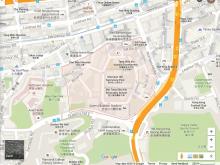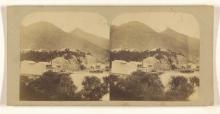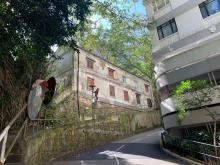Morrison Hill [????-c.1965]
Primary tabs
Morrison Hill was demolished for the Praya East (Wanchai) reclamation in the 1920s.
The hill did not go without a fight.
"To ease the transport of sand and soil, the reclamation tender specified that the fill should come from Morrison Hill. Rail tracks were thus laid from Morrison Hill to the waterfront. It was, however, discovered later that the lower part of Morrison Hill was composed mostly of granite. This did not only delay the reclamation, but also led to a sharp rise in costs (Morrison Hill was finally leveled after the war)."
project.




Comments
Morrison Hill peak
If you had to guess (from the old pictures or from the old maps) where would the peak of Morrison Hill be today?
This is the map to use
This is the map to use http://gwulo.com/node/6108
I'll let you decide and tell us :)
Yikes. Not a single contour
Yikes. Not a single contour to be seen anywhere :-)
What are/were those buildings on top?
The 1931 map from this story would be a much better place to hunt from. Do you know where I could see the full version of this map?
http://gwulo.com/mount-parish-history
"Morrison Education Society
"Morrison Education Society School" http://gwulo.com/node/6942
In the 1901 map it appears that a new building 1,2,3 & 4 Morrision Hill had been built. We have jurors who had those addresses.
And I found this in Europe in China:, 1995
Sir E. Belcher took the true position of Hongkong on a hillock, within a stone's throw of the houses on Morrison Hill, as being in 22° 16' 30" N. Lat. and 114° 08' 30" E. Long.
Morrison Hill 1850s
There were rumors about the demolition of Morrison Hill already in the 1850s. I read this in a German Missionary Report. And here is some more about Morrison Hill from these reports:
In 1851 some of the then abandoned and rotten buildings of the former Morrison Education Society were occupied rentfree by missionaries of the Berlin Ladies Missionary Society for China. The missionaries were 3 ladies and one man. The condition of the buildings was desolate. In one of the stables Dr. Goecking, an independent Missionary and doctor from Halle, Germany, opened an small hospital for Chinese. For a short term the missionaries moved to a house in Garden Street due to the terrible health conditions on Morrison Hill. But they moved back in 1858. Garden Road turned out to be too expensive for the Society. The missionay reports complain that land is so limited and the rental fees are so unbelievable high in Hong Kong (even in Hong Kong some things never change ;-( ) Back on Morrison Hill they had to pay 2/3 of the lease fixed for the place.
In the 1850s Morrison Hill was a long way of Victoria City. Bandits threatened the dwellers. Some of the goats the missionaries kept for milk were stolen. One missionary was attacked, but courageously fought the looters off. A night-watchman had to be hired. The pious missionaries kept a gun in the house and used it to chase bandits off.
On April, 16th 1859 the buildings on Morrison Hill stood for auction. They were called up twelve times; without any reaction by the bidders. Perhaps the rumors about a planned demolition of Morrison Hill explains their reluctance. Sadly the German missionaries had no orders from Berlin to buy the place. Finally he prussian vice-consul Gustav Freiherr von Overbeck threw in $50.- hoping to make a bargain. Now others joined him. In the end the place was sold for $ 3600.- to an Englishman.
Morrison Hill Resumption
Legco 1917
THE GOVERNOR―In connection with Financial
Minute 91, which recommends the payment of a sum
of $275,000 in aid of the vote Public Works
Extraordinary for compensations and resumptions, I
would like to mention that this compensation is for
the resumption of that very picturesque hill called
Morrison Hill and the buildings thereon. This sum of
$275,000 is the sum agreed upon with the owners
www.legco.gov.hk/1917/h171227.pdf
three years ago.
Mid 1950s
Perhaps we can significantly move the goal post for the termination of Morriosn Hill till the mid 1950s (from 1929)! Photo included!
As this China Mail newspaper article from 1949 described it as an 'eyesore'!
Quarrying started in 1918 for the Praya East Reclamation.
Interestingly a Buddhist temple once stood on its summit but was moved elsewhere before WWII
Quarrying for stone re-started in early 1947.
Source: The China Mail, page 3, 1st March 1949
Caption under photo: Morrison Hill, one of the Colony’s eyesores, which, it is reported, will take two to three years to clear (“China Mail” photo).
Several Years To Remove Eyesore
Morrison Hill – one of the eyesores of the Colony – will take two to three years more to be cleared for the further development of Hong Kong, it was unofficially estimated yesterday.
Officially, no estimate of the time when the hill is expected to be completely removed was available yesterday from Government sources.
Work on removal of the hill started in 1918 when all soft material was used for the formation of what was then called the Praya East Reclamation – a considerable portion of the present Wanchai District.
A Buddhist Temple originally occupied the top of Morison Hill. It was moved elsewhere several years before the outbreak of the Pacific War.
It was first believed that Morrison Hill was mainly decomposed rock and easily removed. Later rock was found.
Stone For Building
Quarrying for stone started early in 1947. Since then between 85,000 and 99,000 tons of stone have been quarried principally for Government buildings and road construction. None has been exported, the “China Mail” was officially informed yesterday.
The quarry is at present being worked by contract on which about 340 men are employed in two eight-hour shifts daily.
A Government spokesman said that Morrison Hill will continue to be used as a quarry for stone as long as suitable stone is available. Some of the stone has recently been found to be of inferior quality.
The spokesman added that the proportion of good and bad stone can only be determined as quarrying proceeds, and that the time of removal of the whole hill will depend on the proportions of each quality.
He said that as it is not known exactly when the hill will be wholly removed, no definite plans have yet been made for the future use of the land which will become available.
Its use will depend on the circumstances prevailing at the time the site has been cleared, said the spokesman.
The “China Mail” learned from other sources that one of the plans which Government has under consideration is the construction of a road linking Wanchai Road, Queen’s Road East and Wongneichong Road.
Mid 60s
And it was still a quarry in the 1960s according to this aerial photo: https://gwulo.com/atom/41458